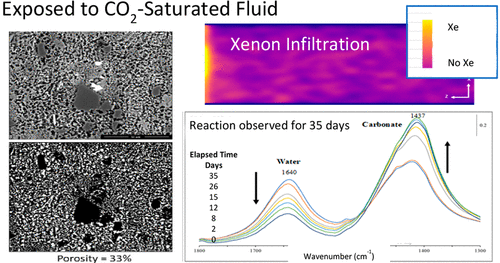当前位置:
X-MOL 学术
›
Energy Fuels
›
论文详情
Our official English website, www.x-mol.net, welcomes your
feedback! (Note: you will need to create a separate account there.)
Reactivity of CO2 with Utica, Marcellus, Barnett, and Eagle Ford Shales and Impact on Permeability
Energy & Fuels ( IF 5.2 ) Pub Date : 2021-09-17 , DOI: 10.1021/acs.energyfuels.1c01995 Angela Goodman 1, 2 , Barbara Kutchko 1, 2 , Sean Sanguinito 1, 2, 3 , Sittichai Natesakhawat 1, 2, 3 , Patricia Cvetic 1, 2, 3 , Igor Haljasmaa 1, 2, 3 , Richard Spaulding 1, 2 , Dustin Crandall 1, 2 , Johnathan Moore 1, 2, 3 , Lauren C. Burrows 1, 2, 4
Energy & Fuels ( IF 5.2 ) Pub Date : 2021-09-17 , DOI: 10.1021/acs.energyfuels.1c01995 Angela Goodman 1, 2 , Barbara Kutchko 1, 2 , Sean Sanguinito 1, 2, 3 , Sittichai Natesakhawat 1, 2, 3 , Patricia Cvetic 1, 2, 3 , Igor Haljasmaa 1, 2, 3 , Richard Spaulding 1, 2 , Dustin Crandall 1, 2 , Johnathan Moore 1, 2, 3 , Lauren C. Burrows 1, 2, 4
Affiliation

|
In order to reduce greenhouse gas emissions while recovering hydrocarbons from unconventional shale formations, processes that make use of carbon dioxide to enhance oil recovery while storing carbon dioxide (CO2) should be considered. Here, we examine samples from three shale basins across the United States (Utica and Marcellus Shales in the Appalachian Basin, Barnett Shale in the Bend Arch-Ft. Worth Basin, and Eagle Ford in the Western Gulf Basin) to address the following questions: (1) do changes from reaction with CO2 and fluids at the micrometer and nanometer scale alter flow pathways and, in turn, impact hydrocarbon production, CO2 storage, and seal integrity and (2) can CO2 or fluid reactivity be predicted based on physical or chemical properties of shale formations? Experiments were conducted at 40 °C and 10.3 MPa to characterize the interaction between CO2 and shale using X-ray diffraction (XRD), carbon and sulfur analysis, in situ Fourier transform infrared spectroscopy (FT-IR), feature relocation scanning electron microscopy coupled with energy-dispersive spectroscopy (SEM-EDS), mercury (Hg) intrusion porosimetry, and Brunauer–Emmett–Teller (BET) surface area and pore size analysis coupled with density functional theory (DFT) methods. Changes in mechanical, physical, and flow properties of shale cores due to CO2 exposure were addressed using a New England Research Autolab 1500 and Xenon X-ray computed tomography (CT) scanning. Results showed that CO2 did not promote significant reactivity with the shale if water was not present; only shales with swelling clays or residual interstitial pore water reacted with dry CO2 to promote reactivity in shale. When water was added as a reactant, CO2 formed carbonic acid and reacted with the shale to dissolve carbonate pockets, etched and pitted the shale matrix surfaces, and increased the microporosity and decreased nanoporosity. Porosity and permeability increased appreciably in core shale samples after exposure to CO2 saturated fluid due to dissolution of carbonate. Shale mechanical properties were not altered. Trends were not observed that could tie CO2 or fluid reactivity to physical or chemical properties of the shale formations at the basin scale from the samples we examined. However, if the shale contained significant amounts of carbonate and water was available to react with the CO2, pore sizes were altered in the matrix and permeability and porosity increased.
中文翻译:

CO2 与 Utica、Marcellus、Barnett 和 Eagle Ford 页岩的反应性以及对渗透率的影响
为了在从非常规页岩地层采收碳氢化合物的同时减少温室气体排放,应考虑利用二氧化碳来提高石油采收率同时储存二氧化碳 (CO 2 ) 的工艺。在这里,我们检查了美国三个页岩盆地(阿巴拉契亚盆地的 Utica 和 Marcellus 页岩、Bend Arch-Ft. Worth 盆地的 Barnett 页岩和西海湾盆地的 Eagle Ford)的样本,以解决以下问题: (1) 与 CO 2和流体在微米和纳米尺度上的反应是否会改变流动路径,进而影响碳氢化合物的生产、CO 2储存和密封完整性,以及 (2) CO 2可以或根据页岩地层的物理或化学特性预测流体反应性?实验在 40 °C 和 10.3 MPa 下进行,使用 X 射线衍射 (XRD)、碳和硫分析、原位傅里叶变换红外光谱 (FT-IR)、特征重定位扫描电子显微镜表征CO 2和页岩之间的相互作用结合能量色散光谱 (SEM-EDS)、汞 (Hg) 侵入孔隙率测定法、Brunauer-Emmett-Teller (BET) 表面积和孔径分析以及密度泛函理论 (DFT) 方法。使用新英格兰研究 Autolab 1500 和氙气 X 射线计算机断层扫描 (CT) 扫描解决了由于 CO 2暴露引起的页岩岩心的机械、物理和流动特性的变化。结果表明,CO2如果不存在水,则不会促进与页岩的显着反应;只有具有膨胀粘土或残余间隙孔隙水的页岩与干燥的 CO 2反应以促进页岩的反应性。当加入水作为反应物时,CO 2形成碳酸并与页岩反应溶解碳酸盐袋,蚀刻和凹坑页岩基质表面,增加微孔率并降低纳米孔率。由于碳酸盐的溶解,在暴露于 CO 2饱和流体后,岩心页岩样品的孔隙度和渗透率显着增加。页岩力学性能没有改变。没有观察到可以将 CO 2联系起来的趋势或流体对我们检查的样品中盆地尺度页岩地层的物理或化学特性的反应性。然而,如果页岩含有大量的碳酸盐并且水可用于与 CO 2反应,则基质中的孔径会改变,渗透性和孔隙度会增加。
更新日期:2021-10-07
中文翻译:

CO2 与 Utica、Marcellus、Barnett 和 Eagle Ford 页岩的反应性以及对渗透率的影响
为了在从非常规页岩地层采收碳氢化合物的同时减少温室气体排放,应考虑利用二氧化碳来提高石油采收率同时储存二氧化碳 (CO 2 ) 的工艺。在这里,我们检查了美国三个页岩盆地(阿巴拉契亚盆地的 Utica 和 Marcellus 页岩、Bend Arch-Ft. Worth 盆地的 Barnett 页岩和西海湾盆地的 Eagle Ford)的样本,以解决以下问题: (1) 与 CO 2和流体在微米和纳米尺度上的反应是否会改变流动路径,进而影响碳氢化合物的生产、CO 2储存和密封完整性,以及 (2) CO 2可以或根据页岩地层的物理或化学特性预测流体反应性?实验在 40 °C 和 10.3 MPa 下进行,使用 X 射线衍射 (XRD)、碳和硫分析、原位傅里叶变换红外光谱 (FT-IR)、特征重定位扫描电子显微镜表征CO 2和页岩之间的相互作用结合能量色散光谱 (SEM-EDS)、汞 (Hg) 侵入孔隙率测定法、Brunauer-Emmett-Teller (BET) 表面积和孔径分析以及密度泛函理论 (DFT) 方法。使用新英格兰研究 Autolab 1500 和氙气 X 射线计算机断层扫描 (CT) 扫描解决了由于 CO 2暴露引起的页岩岩心的机械、物理和流动特性的变化。结果表明,CO2如果不存在水,则不会促进与页岩的显着反应;只有具有膨胀粘土或残余间隙孔隙水的页岩与干燥的 CO 2反应以促进页岩的反应性。当加入水作为反应物时,CO 2形成碳酸并与页岩反应溶解碳酸盐袋,蚀刻和凹坑页岩基质表面,增加微孔率并降低纳米孔率。由于碳酸盐的溶解,在暴露于 CO 2饱和流体后,岩心页岩样品的孔隙度和渗透率显着增加。页岩力学性能没有改变。没有观察到可以将 CO 2联系起来的趋势或流体对我们检查的样品中盆地尺度页岩地层的物理或化学特性的反应性。然而,如果页岩含有大量的碳酸盐并且水可用于与 CO 2反应,则基质中的孔径会改变,渗透性和孔隙度会增加。







































 京公网安备 11010802027423号
京公网安备 11010802027423号